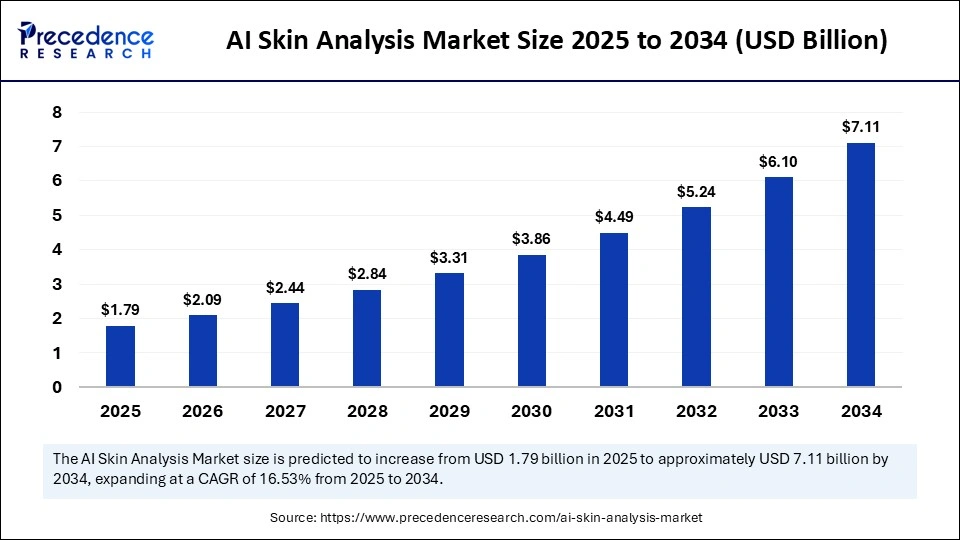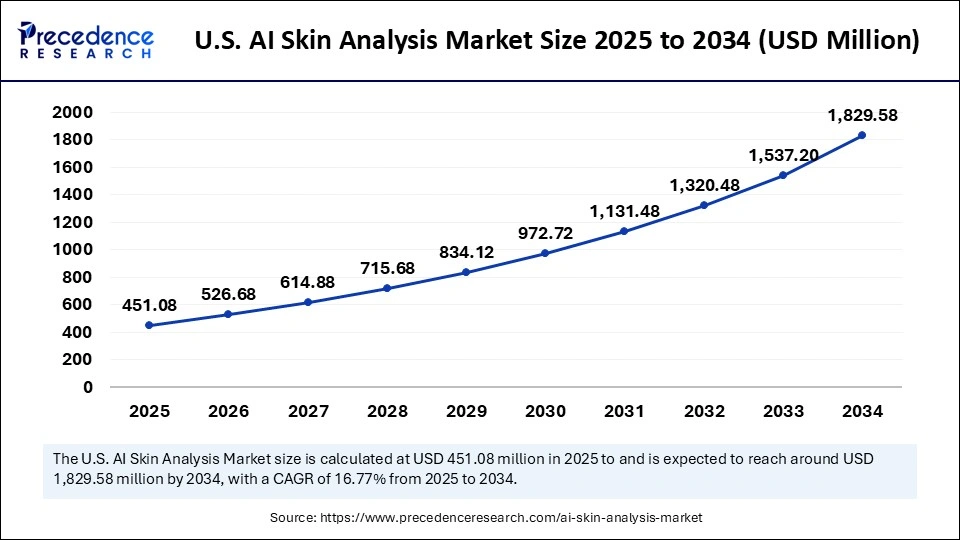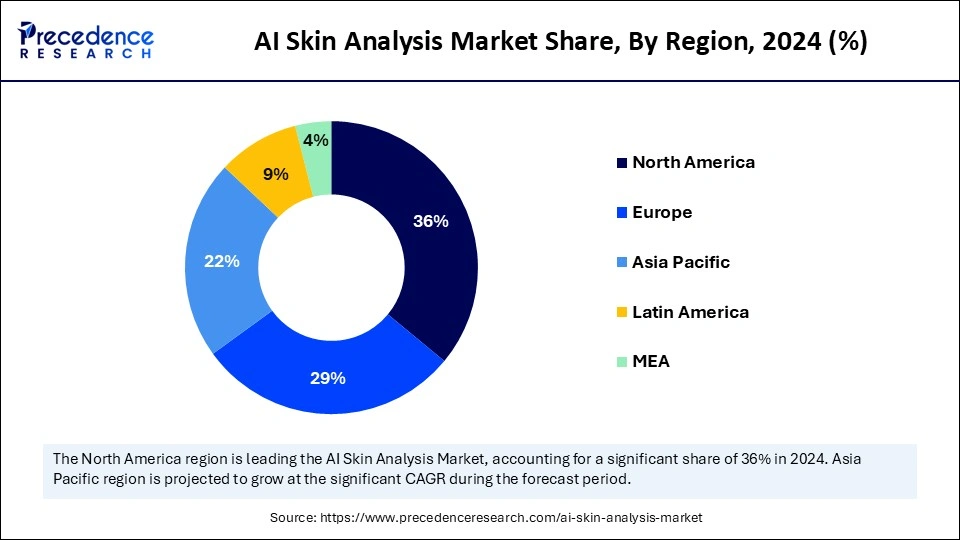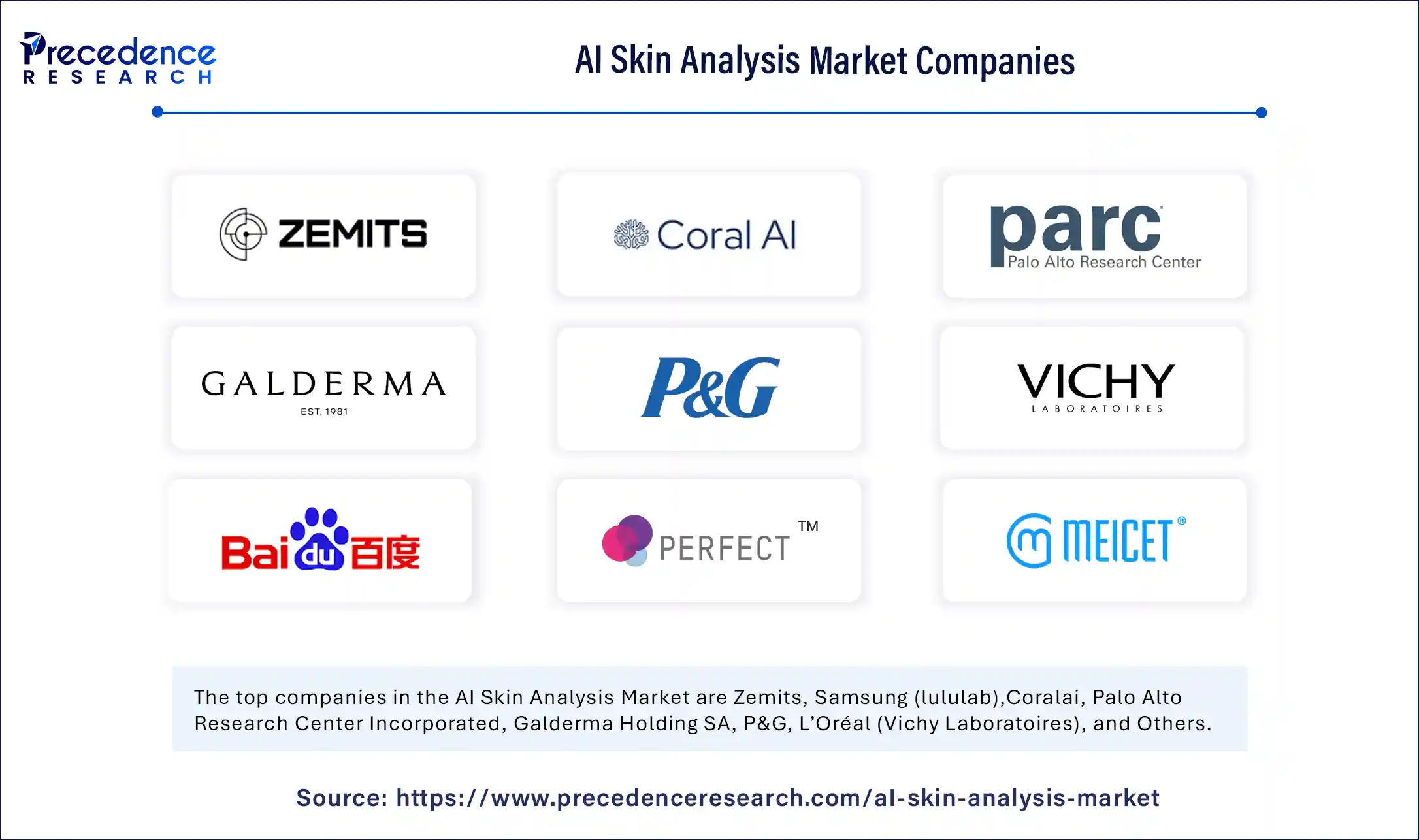List of Contents
AI Skin Analysis Market Size and Forecast 2025 to 2034
The global AI skin analysis market size accounted for USD 1.54 billion in 2024 and is predicted to increase from USD 1.79 billion in 2025 to approximately USD 7.11 billion by 2034, expanding at a CAGR of 16.53% from 2025 to 2034.The rising interest in customized skincare, developments in AI, high awareness of skin health, and integration of intelligent diagnostics in skincare are driving the growth of the AI skin analysis market.

AI Skin Analysis MarketKey Takeaways
- In terms of revenue, the AI skin analysis market is valued at $1.79 billion in 2025.
- It is projected to reach $7.11 billion by 2034.
- The market is expected to grow at a CAGR of 16.53% from 2025 to 2034.
- North America dominated the largest market revenue of 36% in 2024.
- Asia Pacific is expected to witness the fastest growth during the forecast period.
- By component, the solutions segment held the biggest revenue share in 2024.
- By component, the services segment is expected to grow at the fastest CAGR in over the forecast period.
- By technology, the 2D facial recognition segment captured the biggest market share in 2024.
- By technology, the 3D facial recognition segment is expected to expand at the highest CAGR in the coming years.
- By application, the face identification segment held a significant share in 2024.
- By application, the access control segment is anticipated to grow at a rapid pace in the upcoming period.
- By end-user, the healthcare segment led the market in 2024.
- By end-user, the BFSI segment is anticipated to grow at a considerable growth over the forecast period.
U.S. AI Skin Analysis Market Size and Growth 2025 to 2034
The U.S. AI skin analysis market size was exhibited at USD 388.08 million in 2024 and is projected to be worth around USD 1,829.58 million by 2034, growing at a CAGR of 16.77% from 2025 to 2034.

Why Did North America Dominate the Market in 2024?
North America registered dominance in the AI skin analysis market by holding the largest revenue share in 2024. This is mainly due to the heightened adoption rate of artificial intelligence AI technology in healthcare, significant investment by consumers, and many leading companies in the region. The region's strong focus on research and development has facilitated the production of smart AI algorithms that examine various skin conditions with improved accuracy and faster results. The region is expected to maintain its dominance in the market over the forecast period, driven by ongoing technological innovation, rising consumer interest, and the growing use of beauty and healthcare products.
In addition, supportive regulations and increased awareness about early skin disease detection are contributing to market growth. Partnerships between tech companies and skincare websites are providing more people with access to AI for their skincare, increasing AI skin analysis's popularity among the masses.
European AI Skin Analysis Market Trends
Europe was the second-largest shareholder in 2024 and is expected to witness steady growth in the market during the forecast period. With a well-developed beauty and skincare industry and well-informed consumers, more people there seek personalized skin solutions. In Germany, France, and the United Kingdom, customers are willing to use technological tools for individualized advice and treatment regarding their skincare. Furthermore, Europe's high digital proficiency and modern healthcare infrastructure have accelerated the adoption of AI in dermatology and cosmetics. In Germany, several companies are using AI to detect and prevent various skin diseases at the earliest stages. New technology is being used more often in medical research and advanced methods, making it more trustworthy and credible to doctors and patients.

Asia Pacific AI Skin Snalysis Market Trends
Asia Pacific is expected to grow at the highest CAGR in the coming years.
This is primarily due to its large consumer base and the increasing popularity of beauty and skincare products in the region. The growth in the beauty and cosmetics industry is largely a result of the strong focus on beauty in China, Japan, and South Korea, as well as their rapid adoption of new technology. As more people in key regions earn more and move to cities, demand for new beauty technologies is increasing, which helps the market develop faster. China is seeing rapid growth in the use of AI-based personalized skincare products, largely because of significant investment in AI development. Also, with e-commerce across Asia Pacific significantly growing, it is changing the retail space to include AI capabilities for virtual styling, skin inspection, and recommendations.
Market Overview
The AI skin analysis market includes the use of artificial intelligence for the analysis of skin conditions to individualize diagnoses, treatments, and skincare. AI-powered products are helping clinics, research groups, and everyday people at home make better and faster decisions about the skin. This technology is offering dermatologists a chance to care for their patients in every way, including cosmetic services, while changing the practice of dermatology.
Individuals are paying more attention to skincare due to social media and the internet, leading to high demand for personalized solutions. Dermatology clinics and cosmetic companies are leveraging AI for better effectiveness and better support. This suggests that there will be ample opportunity and growth since it can be leveraged in both medicinal and cosmetic care.
What Factors are Fueling the Growth of the AI Skin Analysis Market?
- Growing Consumer Awareness of Skin Health: Consumers have become more conscious about their skin health. Increased online access to information has led to a demand for personalized and precise skincare solutions. AI diagnostics and product recommendations empower individuals to manage their skin health at home or in clinics.
- Expansion of At-Home Skincare Devices: People are becoming more interested in skincare solutions they can do in the comfort of their homes. It is now possible to keep watch over one's skin health at home using special mobile apps or mirrors.
- Dual Application in Medical and Aesthetic Fields: AI skin analysis technology is used in medicine and cosmetic treatments to assess the skin. Dermatologists use AI to identify skin issues, but it also gives cosmetic companies the solutions to their customer skincare problems.
Market Scope
| Report Coverage | Details |
| Market Size by 2034 | USD 7.11 Billion |
| Market Size in 2025 | USD 1.79 Billion |
| Market Size in 2024 | USD 1.54 Billion |
| Market Growth Rate from 2025 to 2034 | CAGR of 16.53% |
| Dominating Region | North America |
| Fastest Growing Region | Asia Pacific |
| Base Year | 2024 |
| Forecast Period | 2025 to 2034 |
| Segments Covered | Component, Technology, Application, End-user, and Region |
| Regions Covered | North America, Europe, Asia-Pacific, Latin America, and Middle East & Africa |
Market Dynamics
Drivers
Growing Demand for Personal Skincare and Early Detection
The rising demand for personal skincare products and early detection of skin diseases is a major factor driving the growth of the AI skin analysis market. The evolution of AI technology addresses this demand as it facilitates the complex process of evaluating multiple skin issues, such as acne, pigmentation, line and wrinkles, and sensitivity through image analysis. Based on facial images, lifestyle information, and environmental factors, AI provides detailed skin insights, leading to customized treatment and product recommendations. This trend is particularly popular among Gen Z and millennials, driven by social media and the desire for improved skin. Consequently, demand is increasing in both medical and home settings, with customized treatments and early problem detection being key drivers of market growth.
Restraint
High Cost of Advanced AI Skin Analysis Tools
The high cost of advanced AI tools is a major factor restraining the growth of the AI skin analysis market. While advancements in AI systems offer improved imaging, data processing, and real-time capabilities, they require regular maintenance, which increases operational costs. Consequently, many consumers in price-sensitive markets cannot afford the necessary devices. Healthcare centers also face additional expenses for software, data security, and staff training, further impacting costs. Moreover, lack of awareness in some areas about the benefits of AI skin analysis limits the market growth.
Opportunity
Technological Advancements
Smartphones, tablets, and wearables with improved cameras and processors enable AI-based skin diagnostics. This enables people to receive personalized skin care recommendations through their phones or smart mirrors, eliminating the need to purchase professional equipment. More people who are tech-savvy are choosing digital health tools and wellness applications. An increase in telehealth and virtual visits for dermatology also opening up new growth avenues. AI skin analysis can be used as a first screening method, providing dermatologists with images and data for fast and accessible diagnoses.
Component Insights
Why Did the Solutions Segment Dominate the AI Skin Analysis Market in 2024?
The solutions segment dominated the market with the largest revenue share in 2024. This is mainly due to the rapid increase in the adoption of AI-based tools in the field of dermatology. Deep learning technologies enable these solutions to analyze a wide array of skin conditions, providing users with direct remedy suggestions. The integration of AR, VR, and IoT devices alongside AI-supported skin analysis tools enhances the engagement, enjoyment, and accessibility of skin diagnostics for all. AI-supported solutions are crucial for navigating skincare routines and facilitating customer communication. As skincare becomes increasingly tailored to individual skin types and more reliant on technology, the demand for these technologies is expected to rise, with companies actively seeking AI-supported solutions for innovation, aesthetic enhancements, and remote diagnostic capabilities.
The services segment is expected to grow at the fastest CAGR over the forecast period. This is mainly due to the escalating demand for personalized assistance, training, and routine maintenance within AI systems for dermatology. Clinics and businesses rely on service providers to ensure seamless integration and the reliable operation of all AI tools, encompassing cloud analysis, regular algorithm updates, and teleconsultation services. Moreover, the integration of AI by both healthcare providers and dermatologists is becoming commonplace, enabling them to tailor treatments and reduce diagnostic inaccuracies.
Technology Insights
Why Did 2D Facial Recognition Dominate the Market in 2024?
The 2D facial recognition segment dominated the AI skin analysis market with a major revenue share in 2024. The widespread affordability, ease of use, and compatibility with devices like smartphones, tablets, and webcams make 2D facial recognition accessible to many consumers. Furthermore, the use of 2D facial recognition enabkes remote evaluation of skin issues, suppirting telehealth in dermatology. Due to the incorporation of this mode of review, doctors can follow-up with patients remotely, which reduces their workload while patient outcomes.
The 3D facial recognition segment is expected to expand at the highest CAGR in the upcoming period. 3D facial recognition uses contour mapping to identify details of a person's face and check the condition of their skin, providing a comprehensive skin analysis. 3D tools are essential in dermatology for understanding skin characteristics and detecting skin disorders like melanoma, rosacea, and psoriasis in their initial stages. Professionals are increasingly proficient in using 3D technologies to identify irregularities and monitor the effects of intervention therapies. Due to advancements in dermatology and simplified diagnostics, 3D facial recognition has a significant opportunity to transform both professional skin diagnostics and personal skincare management.
- In December 2024, a digital human startup based in South Korea, EntreReality, has officially started operations in global beauty tech by officially launching Twinit AI Makeup. Twinit is on the leading edge of new technology, combining AI with 3D to change the cosmetics experience for users worldwide.
(Source: https://www.prnewswire.com)
Application Insights
What Made Face Identification the Dominant Segment in the Market?
The face identification segment dominated the AI skin analysis market with the largest revenue share in 2024 because it has become popular in beauty tech and skincare. With the help of AI and NLP, it is possible to analyze the face and find multiple skin problems with great accuracy. Thanks to AI technology, medical professionals can now identify skin issues early through face identification and offer personalized treatment plans without requiring in-person visits. Because face identification is done instantly by AI, both users and businesses can enjoy more efficient and satisfactory results.
The access control segment is expected to grow at a rapid pace during he forecast period. Verification systems are being implemented in the banking sector, corporate offices, healthcare sites, and public transport to enhance security and streamline access. The processing speeds of AI, coupled with facial recognition, expedite tasks and simplify user experiences. Overall, integrating AI skin analysis with biometric security enables the access control segment to offer safe, efficient, and contactless authentication solutions that meet consumer demands.
End-user Insights
How Does the Healthcare Segment Dominate the AI Skin Analysis Market in 2024?
The healthcare segment dominated the market with the largest share in 2024. By utilizing AI to analyze faces, healthcare professionals can now diagnose skin disorders accurately, assess progress and develop care plans that specifically match each patient's skin. Thanks to the sophistication of computer algorithms, AI can analyze and make reliable determinations and accurate counts regarding skin disorders like acne and eczema, and in the early stages of melanoma. As the medically assisted use of artificial intelligence increases, doctors and medical treatment centers are asking for more AI systems related to dermatology and plastic surgery.
The BFSI segment is expected to grow at a significant CAGR in the coming years. The growth of the segment is attributed to the increasing use of AI-based facial recognition and skin analysis for identity verification, fraud prevention, and secure customer onboarding. These services enhance security by checking a user's biometric skin marks and facial features during authentication. Consequently, this reduces the risk of personal information theft and allows customers to enjoy quick and simple authentication. Furthermore, remote banking and technology-related services have gained popularity faster.
Recent Developments
- In April 2025, Perfect Corp., a global leader in augmented reality (AR) and AI beauty and fashion tech, announced the partnership with Spanish techno-beauty brand UNICSKIN to elevate the online skincare shopping experience with advanced AI San assessments. The partnership incorporated Perfect Corp's AI Skin Analysis technology into UNICSKIN's e-commerce platform, offering shoppers personalized LED mask recommendations based on their real-time skin condition.
(Source:https://www.businesswire.com)
- In January 2025, Spectricity announced a new skin analysis experience to create the next generation of smart skin care. This new skin analysis experience uses multispectral imager (MSI) on a mobile and lululub's AI algorithms to communicate with consumers without any technological boundaries, offering personalized skin care recommendations from just about anywhere.
(Source:https://spectricity.com)
- In July 2024, Perfect Corp. announced New Upgraded HD AI Skin Analysis Solution, enabling hyper-personalized skincare recommendations. The upgraded HD Skin Analysis helps skin scans at 2x resolution, which provides greater accuracy. It analyzes more details and enables listed skincare brands to suggest the best product for each customer.
(Source:https://www.businesswire.com)
AI Skin Analysis Market Companies

- Zemits
- Samsung (lululab)
- Coralai
- Palo Alto Research Center Incorporated
- Galderma Holding SA
- P&G
- L'Oréal (Vichy Laboratoires)
- Baidu
- Perfect Corp
- Meicet Technology Co., LTD
- Beijing Megvii Technology Co., Ltd.
- Shanghai Shanglu Network Technology Co., Ltd.
Segments Covered in the Report
By Component
- Solutions
- Services
By Technology
- 2D facial recognition
- 3D facial recognition
- Thermal face recognition
- Skin texture analysis
By Application
- Face identification
- Access control
- Security & surveillance
By End-user
- BFSI
- Healthcare
- Government & defense
- IT & telecom
- Retail & ecommerce
- Automobile & transportation
By Region
- North America
- Asia-Pacific
- Europe
- Latin America
- Middle East & Africa
For inquiries regarding discounts, bulk purchases, or customization requests, please contact us at sales@precedenceresearch.com
Frequently Asked Questions
Ask For Sample
No cookie-cutter, only authentic analysis – take the 1st step to become a Precedence Research client